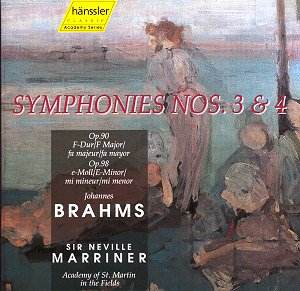|
|
Search MusicWeb Here |
|
 |
||
|
Founder:
Len Mullenger (1942-2025) Editor
in Chief:John Quinn
|
|
|
Search MusicWeb Here |
|
 |
||
|
Founder:
Len Mullenger (1942-2025) Editor
in Chief:John Quinn
|
 |
Johannes BRAHMS (1833-1897)
Symphony No.3 in F major Op.90 (1883) Symphony No.4 in E minor Op.98 (1887) Recorded at Henry Wood Hall, London in October and November 1997 |
| CD available for post-free online mail-order or you may download individual tracks. For some labels you can download the entire CD with a single click and make HUGE savings. The price you see is the price you pay! The full booklet notes are available on-line. |  |
|
NOTE • Click on the button and you can buy the disc or read the booklet details • You can also access each track which you may then sample or down load. • Further Information. |
|
|
The ambivalent attitude of Brahms to the symphony is well documented; despite pleas from his friends and publisher Fritz Simrock, it took him until he was in his forties before he could shake off the looming presence of Beethoven (and that ninth symphony in particular) and dared trust himself to produce his first essay in the form. By the time he turned fifty (in 1883) he was embarking on his third, considered the most Brahmsian of the four yet, it would appear, not as popular as the first or fourth with the public. Perhaps the answer lies in the conundrum regarding its motto theme F-Ab-E, a corruption of the use of F-A-F in earlier youthful works. ‘Free but happy’ (‘frei aber froh’) by middle age becomes the more resigned ‘free but lonely’ (‘frei aber einsam’), with the middle note A flat reflecting the sadness of the way in which his life had developed. Yet the music is full of sumptuous melody and lush textures as well as the Sturm and Drang implicit in this coded message.
As the second symphony had followed hard on the heels of the first, so it was soon after the first performance of the third (2 December 1883 under Hans Richter in Vienna) when the first two movements of the fourth were penned during idyllic summer holidays in the years 1884 and 1885. This time the premiere of the fourth was entrusted to his friend Hans von Bülow and his Meiningen Orchestra, ‘No.4 colossal, completely singular, completely new, brazen individuality. Breathes unheard-of energy from A to Z’, he wrote to Simrock. Its ‘completely singular’ quality is no more apparent than in the finale which takes the form of a Passacaglia, a colossal structure based on an eight-bar theme taken from a cantata, ‘Nach dir, Her, verlangt mich’ (BWV 150) by Bach, a composer Brahms revered.
There was a time, say forty years ago, when the Academy of St Martin in the Fields was a conductorless string ensemble spearheading the Baroque revival, but on this 1997 disc it numbers one hundred players or so and the names listed in the booklet make impressive reading in all sections of the orchestra. Marriner’s readings of both works neither hang about nor indulge, and moreover require such forces for they focus on thick string textures, dark colours and the lyricism of warm tone. Solos are beautifully taken and lucidly phrased, none more so than those by the conductor’s clarinettist son in the Poco allegretto scherzo of the third symphony. Compelling listening.
Christopher Fifield
|
Symphony No. 4 in E Minor Op. 98 Allegro
energico e passionato Get a free QuickTime download here |
|
ADDITIONAL INFORMATION •
You can sample only 30 seconds (or 15% if that is longer) of a given track. Select from the View tracks list. Each sample will normally start from the beginning but you can drag the slider to any position before pressing play. • PLEASE NOTE: If you are behind a firewall and the sound is prematurely terminated you may need to register Ludwig as a trusted source with your firewall software.
•You will need Quicktime to hear sound samples. Get a free Quicktime download here • If you cannot see the "Sample All Tracks" button you need to download Flash from here.
|
|
|
Return to Index |